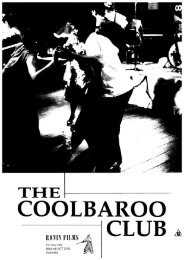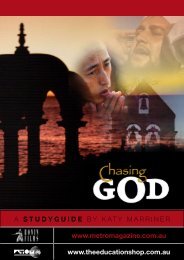to download THE LAST TASMANIAN study guide - Ronin Films
to download THE LAST TASMANIAN study guide - Ronin Films
to download THE LAST TASMANIAN study guide - Ronin Films
You also want an ePaper? Increase the reach of your titles
YUMPU automatically turns print PDFs into web optimized ePapers that Google loves.
<strong>THE</strong> HIGHLY ACCLAIMED 1978 DOCUMENTARY BY TOM HAYDON AND ARCHAEOLOGIST RHYS JONES<strong>THE</strong><strong>LAST</strong> <strong>TASMANIAN</strong><strong>THE</strong> STORY OF <strong>THE</strong> SWIFTEST AND MOST DESTRUCTIVE GENOCIDE ON RECORDThe Tasmanians were a distinct people, isolated from Australia and the rest of the world for 12,000 years.In 1803, British colonisation began and in 1876,Truganini died. She was the last full-blood and tribal TasmanianAboriginal.Within her one lifetime, a whole society and culture were removed from the face of the earth.STUDY GUIDE
<strong>THE</strong> <strong>LAST</strong> <strong>TASMANIAN</strong><strong>THE</strong> <strong>LAST</strong> <strong>TASMANIAN</strong> had an extraordinary impact upon a very wide public in the yearsfollowing its first release in 1978.The film has been credited by his<strong>to</strong>rians with substantiallyaltering Australian perceptions of their past and critically affecting contemporary attitudes of bothblack and white Australians. It is a very important documentary. But it is also a deeply moving,clearly communicating and finely crafted work: most notable for its deliberate eschewing ofsensationalism in approaching so potent a subject.The s<strong>to</strong>ry this film tells requires <strong>to</strong> be <strong>to</strong>ld again and again, <strong>to</strong> each generation. Its methodremains ever fresh: a pioneering achievement in his<strong>to</strong>rical detective work. Here is not emotivetract or ephemeral agit-prop, but a true document of what occurred. As one British reviewer said,<strong>THE</strong> <strong>LAST</strong> <strong>TASMANIAN</strong> is the record.A leading Australian educational journal declared “<strong>THE</strong> <strong>LAST</strong> <strong>TASMANIAN</strong> is a must – amemorable cinematic experience for students, teachers and the general public. Miss it and youwill miss the best Australian film of the year.”Until now, release of <strong>THE</strong> <strong>LAST</strong> <strong>TASMANIAN</strong> in Australia has been restricted <strong>to</strong> cinema,television and specially arranged screenings in educational institutions. Now it is available on DVD,complete with the Study Guide.These notes are intended <strong>to</strong> help teachers and other who co-ordinate discussion of this film.Theyprovide a synopsis and summary of the film’s content; and some background on the making of thefilm and the impact it created.They also suggest some points for discussion.PAGE2
<strong>THE</strong> <strong>LAST</strong> <strong>TASMANIAN</strong>SYNOPSIS<strong>THE</strong> <strong>LAST</strong> <strong>TASMANIAN</strong> tells the s<strong>to</strong>ry of the swiftest and most destructive genocide on record.The Tasmanians were a distinct people, isolated from Australia and the rest of the world for12,000 years.In 1803, British colonisation began and in 1876,Truganini died. She was the last full-blood andtribal Tasmanian Aboriginal.Within her one lifetime, a whole society and culture were removedfrom the face of the earth.PAGE2
<strong>THE</strong> <strong>LAST</strong> <strong>TASMANIAN</strong><strong>THE</strong> STORY IN SUMMARYThe film opens with a state funeral in 1976 for the remains of Truganini who died a hundredyears before. She was the last full-blood Aborigine in Tasmania.The British colonised Tasmania in 1803.There were then some 4,000 Aborigines. By 1876, whenTruganini died,Tasmania was empty of Aborigines. It is the swiftest and most complete case ofgenocide on record.12,000 years before, the rising sea had cut of Tasmania from Australia: the Tasmania Aborigineswere the most isolated people in recorded his<strong>to</strong>ry.The film follows Dr Rhys Jones, archaeologist and anthropologist, in his search <strong>to</strong> discover andcomprehend the life and death of the Tasmanian Aborigines. He has pioneered recent explorationof Tasmania’s prehis<strong>to</strong>ry. Archaeology has revealed that Aborigines were in Tasmania long before itbecame an island.After this introduction, the film proceeds in 3 parts:BEFORE 1803 - ANCESTORSBeginning in 1963, Dr Rhys Jones, with archaeologist and his<strong>to</strong>rian Dr Jim Allen, under<strong>to</strong>ok anarchaeological survey around the coast of Tasmania. He also searched the records left by earlierexplorers.In 1642, Abel Tasman discovered the south coast naming it Van Diemen’s Land. In 1777, CaptainCook paid a brief visit. His meeting with them provided the first known pictures of theTasmanians.They differed from the Aborigines on the Australian mainland.The Tasmanians werewholly naked, had woolly hair and did not catch or eat fish.In 1772, a French expedition brought back the first detailed records. Amongst many things, theyshowed that while the Tasmanians dived for shellfish, they would have nothing <strong>to</strong> do with scalefish.The discoveries fired the imagination of Francois Peron, a young hero of the FrenchRevolutionary wars. A naturalist and medical doc<strong>to</strong>r, Peron had been strongly influenced by theFrench philosophers who inspired the Revolution. In particular, by Jean-Jacques Rousseau whodenounced civilisation and exalted nature, creating an idealised vision of the ‘noble savage’.Peron became the leading member of a new French expedition, which left for Tasmania in 1800.He was <strong>to</strong> compile, just in time [before the British arrived], the only full account of the Aboriginesin their pristine state.Rhys Jones and Jim Allen reconstructed the simple windbreak shelter on the beach where, in1802, Peron and his artist friend, Charles Lesueur, first met the Tasmanian Aborigines. Here, theFrenchmen found the few small objects which represented almost the whole technology of theTasmanians.There was an enormous gap between the Tasmanian technology and that used byAborigines on the Australian mainland.The Australians had 120 items.The Tasmanians had only 22:no boomerangs, no spear throwers, no nets, no dogs.Theirs was the simplest technology in theworld.At first Peron thought he had realised his vision of the ‘noble savage’. But after the first idyllicmeeting, he had subsequent experiences that were not so cordial. As for the Tasmanians’ simpleand natural life, he began wondering about its ‘privations and miseries’.These Aborigines did noteven know how <strong>to</strong> make fire, having always <strong>to</strong> transfer a flame from one stick <strong>to</strong> another.PAGE3
<strong>THE</strong> <strong>LAST</strong> <strong>TASMANIAN</strong>On the other side of Bass Strait, 320 kilometres [200 miles] away, the Australian Aborigines, ofcourse, did know how <strong>to</strong> make fire.The Aborigines had once walked across the land which BassStrait had drowned 12,000 years ago.Why had the Tasmanian culture become so different fromthe culture on the Australian mainland?Rhys Jones excavated in two caves at Rocky Cape which projects in<strong>to</strong> Bass Strait. From 8,000years ago continuing <strong>to</strong> 3,500 years ago, he found many fish bones; and also <strong>to</strong>ols made fromanimal bones.These <strong>to</strong>ols were needles and punches, used almost certainly for the making ofclothes. All these, the fish bones and the <strong>to</strong>ols for making clothes, disappeared 3,500 years agoand never returned.Why, at 3,500 years ago, had the Tasmanians suddenly s<strong>to</strong>pped catching fish, s<strong>to</strong>pped wearingclothes? Jones wondered: was it a result of separation from the Australian continent, a loss ofideas?The Tasmanians did have a watercraft of paperbark. Might they have used this <strong>to</strong> overcome theirisolation? Jones had the watercraft reconstructed: but the paperbark absorbed water.This craftcould travel only a few kilometres from the coast.Rhys Jones concludes there was <strong>to</strong>tal isolation during the last 12,000 years. During these 250generations, no new ideas were coming in<strong>to</strong> the system. He thinks the archaeological recordshows a steady, slow inexorable squeezing – simplification of the technology.Jones and Allen reflect on the way the Tasmanian Aborigines viewed the world before theEuropeans arrived.The Tasmanians’ universe was an island surrounded by water and they knewevery human being inside that universe until their his<strong>to</strong>ry ended in catastrophe. Jones suggeststhat the catastrophe began 12,000 years ago when the sea blocked off Tasmania. In a sense, thedoom of the Tasmanians was sealed by that event.The doom of the Tasmanians was consummated by a nation which was then the mosttechnologically advanced in the world.The British became alarmed at the French presence. At theend of 1802, the British Empire <strong>to</strong>ok possession of Tasmania.AFTER 1876 - <strong>THE</strong> DESCENDANTSAnother reason for the British interest, was an important economic resource: seals.The Britishsealers also raided the Tasmanian coast for Aboriginal women. From this mating there emerged acommunity of mixed blood descendants. Most of these people came from about a dozen originalfamilies who lived on various islands in Bass Strait and finally gathered in<strong>to</strong> one community onCape Barren Island.During March and April each year, some of the descendants keep up a tradition of going <strong>to</strong>various islands in the Strait and collecting the young mut<strong>to</strong>n-birds. For millions of years, themut<strong>to</strong>n-birds have flown from Alaska <strong>to</strong> spend the southern summer on these islands and hatchtheir young.While she plucks and cleans mut<strong>to</strong>n-birds, Annette Mansell declares that she is ‘a descendant. I’mnot an Aboriginal, I’m only a descendant of one.’ At the time of filming, Annette was President ofthe Cape Barren Island Community. She contends ‘there’s a hell of a difference’ between the wayof living of the descendants and ‘the old Aboriginals that were here’.‘There are no Aboriginals now,’ says Annette.‘There’s not much in any of us, there’s no tradition inTasmania with the Aboriginals.’ She claims nothing survives of the Aboriginal language in Tasmania.PAGE4
<strong>THE</strong> <strong>LAST</strong> <strong>TASMANIAN</strong>Annette Mansell’s views are endorsed by Melvyn Everett,‘boss’ of this mut<strong>to</strong>n-birding group.‘No, Idon’t really class myself as an Aboriginal,’ he says.These people explain the descendants know nothing about the old Aboriginal traditions.‘It’s onlyhis<strong>to</strong>ry what we’ve learnt as you’ve learnt.’But the wiping out of the Tasmanian Aborigines is a his<strong>to</strong>ry largely unwritten. During the first 25years of their colony, the British made no pic<strong>to</strong>rial records at all of the Aborigines.The new emptylandscape is the only witness <strong>to</strong> most of what happened.1803-1876 - EXTINCTIONThe British established their first colony near Hobart in 1803.Within eight months, they had theirfirst encounter with the Aborigines: it became a massacre of the natives.The British viewed Tasmania as a natural prison for the very worst of their transported convicts.The convicts were let loose in<strong>to</strong> the bush <strong>to</strong> hunt kangaroos and, in the process, committedhideous atrocities upon the Aborigines.Then free settlers, many of them former British Armyofficers, came with vast flocks of sheep and the Aborigines lost their hunting grounds. Finally, theAborigines retaliated and mounted a surprisingly effective guerrilla campaign.Their prime targetswere lone shepherds in their huts on the far-flung perimeters of advancing sheep farms.The Aborigines lived by hunting and were excellent spearmen.They were also accus<strong>to</strong>med <strong>to</strong>violence in their own society because the 4000 or so of their population were divided in<strong>to</strong> manysmall bands, belonging <strong>to</strong> nine separate tribes and speaking five different languages. Each tribe hadits own terri<strong>to</strong>ry and were often deadly enemies. A frequent cause of war was the abduction ofwomen for marriage. But in the growing conflict with the whites, the Aborigines were outclassedin armaments and increasingly outnumbered.With their apparently infinite supply of people, thewhites could replace anyone killed, the Aborigines could not.The British colonists at first regarded the Aborigines only with contempt, viewing them as lessthan human.Then, as Europeans were killed on remote properties, the colony was gripped withmounting fear and hate of native people.The racial conflict became an actual ‘Black War’. Gun slitswere built in<strong>to</strong> woolsheds and homesteads were fortified. Detachment of troops were based atkey points around the frontier of the settled regions.Heading the colony’s government was Lieutenant-Governor George Arthur, an Army Colonel.Officially, Governor Arthur preached the policy of kindness and reconciliation with the natives,which the British Government in London had called for. But the Government had established noway of communicating with the natives and had <strong>to</strong> resort <strong>to</strong> picture boards hung on trees!In practice, Arthur permitted and then authorised military and civil action, which led <strong>to</strong> more andmore killing of Aborigines. As white deaths also mounted, he declared martial law, under whichAborigines were forbidden <strong>to</strong> enter the settled regions.Then a bounty was placed on their heads.The colonists became gripped with the fervour of driving every black from the face of the earth.The diminishing Tasmanians retreated in<strong>to</strong> the high and ruggedly mountainous country ofTasmania and from there, sustained the fight. Under hysterical pressure from the colonists, whoseimagination wildly exaggerated the Aboriginal numbers, Governor Arthur finally resorted <strong>to</strong> alarge-scale military campaign. His ‘Black Line’ of troops and civilians conducted a huge sweep ofthe colonised regions, but was a dismal failure.PAGE5
<strong>THE</strong> <strong>LAST</strong> <strong>TASMANIAN</strong>Governor Arthur then turned <strong>to</strong> a psychological solution, in the person of a ‘concilia<strong>to</strong>r’ whowould use persuasion.This was George Augustus Robinson.Robinson, a bricklayer by trade and a lay-preacher, was both zealous and ambitious. He formed asmall party of Aboriginal collabora<strong>to</strong>rs, foremost of whom was Truganini. At the time Robinsonmet her, she was a young and lively woman. Both she and her community had suffered extremelyfrom the European impact.With Truganini and the others in his team, Robinson under<strong>to</strong>ok manyarduous expeditions in<strong>to</strong> the wild and unexplored interior.With fine promises, he succeeded inrounding up the remaining, and demoralised, Aborigines.The last groups were collected from theremote west coast where they posed no threat <strong>to</strong> the colonists. But Government and colonistswanted every Aborigine gone and Robinson brought in these last people for major financialreward.Thus were all the remaining Aborigines found and gathered and then, despite Robinson’spromises, they were deported <strong>to</strong> offshore Flinders Island.There, Robinson ran a Governmentsettlement <strong>to</strong> force-feed them ‘civilisation’.They responded by dying and obsessively, Robinsonplanned every detail of their graves in advance. Finally, he would return <strong>to</strong> England a moderatelyrich man.The last remnant of the Aborigines, past breeding age, were sent <strong>to</strong> Oyster Cove, southof Hobart, where alcohol and influenza abetted melancholy in sending them <strong>to</strong> their death.Science pursued the bodies of the last Aborigines.The new theory of Evolution appeared <strong>to</strong>justify the extinction of these ‘lesser’ people and also made them objects of intense scientificcuriosity.They were seen as representing an earlier stage of human development which hadsomehow lingered in remote Tasmania. Distinguished scholars robbed graves and rival doc<strong>to</strong>rsghoulishly mutilated corpses after death.The Royal College of Surgeons in London amassed thelargest collection of skulls. In 1941, a German incendiary bomb landed in the midst of thecollection and the debris, it is said, was swept in<strong>to</strong> the foundations of the new building.Truganini’s body suffered a similar fate after her death in 1876. Her skele<strong>to</strong>n was long displayed inHobart. It was on the centenary of her death that a Government, which now sought ‘<strong>to</strong> makeamends’, gave her remains a State Funeral.The present Aboriginal descendants were there <strong>to</strong>attend the funeral service and later cast her ashes in the sea from the Governor’s launch.PAGE6
<strong>THE</strong> <strong>LAST</strong> <strong>TASMANIAN</strong><strong>THE</strong> CONTROVERSY<strong>THE</strong> <strong>LAST</strong> <strong>TASMANIAN</strong> had its first release in Australia in 1978. Its primary impact was inalerting white Australians that genocide was a fundamental aspect of their his<strong>to</strong>rical heritage. Butthe film also had its impact upon black Australians. Many Aborigines found it emotionallydistressing but at the same time a welcome illumination of events they had only known in roughoutline.However, from some Tasmanian Aborigines, there came protest, based on their view that the filminferred they no longer existed.The makers of the film encouraged this protest <strong>to</strong> be publiclyaired and, at their urging, was covered by the media, culminating in a one hour debate on ABCTelevision’s Monday Conference between filmmaker Tom Haydon and Aboriginal spokesmanMichael Mansell.Much has been written on this issue. Michael Mansell and others object that in its title, itsemphasis upon the extinction of traditional Tasmanian Aborigines and, in its treatment ofAboriginal descendants, the film denies the identity of those who <strong>to</strong>day call themselves ‘TasmanianAborigines’.It is important <strong>to</strong> put this controversy in his<strong>to</strong>rical context. At the time <strong>THE</strong> <strong>LAST</strong> <strong>TASMANIAN</strong>was being prepared and indeed filmed, the descendants of the original Tasmanians [there are nowsome 3000 of them] were still mostly calling themselves ‘descendants’ or ‘Cape Barren Islanders’and so they were termed in print by his<strong>to</strong>rians and other commenta<strong>to</strong>rs of the time [one or twoof these later joined with Mansell in his critique]. Before ever commencing the s<strong>to</strong>ry of genocide,the film devotes a section <strong>to</strong> ‘The Descendants’, explaining how these offspring of someAboriginal women and white sealers have survived in<strong>to</strong> the present day.The one woman whopresents her views in detail was chosen because she was then President of the Cape BarrenIsland Community, the traditional home of the Descendants.This Annette Mansell [cousin ofMichael] says she is ‘not Aboriginal, but a Descendant of one…’. Quite accurately, she says thelanguage of the old Aborigines has not survived.Political activism was gathering force among Tasmania’s Aboriginal descendants, even as the filmwas being made, and the film’s emphasis on the termination of their forebears’ society did providean ideal opportunity for winning public attention <strong>to</strong> their new resolve <strong>to</strong> be ‘TasmanianAborigines’ still. In this sense, some his<strong>to</strong>rians have depicted <strong>THE</strong> <strong>LAST</strong> <strong>TASMANIAN</strong> as itselfplaying a significant role in the development of racial identity among these people.PAGE7
<strong>THE</strong> <strong>LAST</strong> <strong>TASMANIAN</strong>The makers of <strong>THE</strong> <strong>LAST</strong> <strong>TASMANIAN</strong> have always said the issue involved in this controversy isessentially a semantic one.The film uses the terms ‘Tasmanian Aborigines’ and ‘Tasmanians’ just asother his<strong>to</strong>rians and commenta<strong>to</strong>rs have used it, <strong>to</strong> apply <strong>to</strong> the first people who occupied theisland and created there a distinctive society and culture. An old-fashioned term for distinguishingsuch people from their ‘mixed-blood’ descendants was ‘full-blood’ and this term is used in the filmwhen it refers <strong>to</strong> Government definition. But <strong>THE</strong> <strong>LAST</strong> <strong>TASMANIAN</strong> takes an his<strong>to</strong>rical viewrather than a genetic one.What crucially distinguishes those Aborigines who lived in Tasmaniawhen the Europeans arrived, was their possession of a social system and culture uniquely theirown.The genocide conducted by the colonists not only meant no ‘full-blood’ Aborigines existed inTasmania after Truganini’s death, it meant the society and culture of those people were also gone.Nothing of the old traditional tribal life has survived, except for a few odd things like making shellnecklaces. Language, religion, s<strong>to</strong>ries, song, dance, relationship <strong>to</strong> country and so on are all gone.The Descendants, <strong>to</strong>day’s ‘Tasmanian Aborigines’, evolved a new variety of society and culture onthe off-shore island [Cape Barren Island] which was for a long time their home.That island wasnot occupied by the original Tasmanian Aborigines. And its traditions owed more <strong>to</strong> the sealerforefathers than the Tasmanian Aboriginal foremothers.The film and its makers do not question the right of <strong>to</strong>day’s Tasmanian Aborigines <strong>to</strong> callthemselves that.The primary concern of the film happens <strong>to</strong> be with the fully tribal andtraditional-living Aborigines of the eighteenth and nineteenth centuries, from whom these presentpeople are descended. From that perspective, when the film describes the Mansells and theircontemporaries as ‘Descendants’, its logic is the same as when it describes the earlier, prehis<strong>to</strong>ricpeople of Tasmania as ‘Ances<strong>to</strong>rs’.The makers are adamant that the politics of the present, whether they be generated by activistsor conservatives, should not be allowed <strong>to</strong> cloud the view of a major and tragic episode inAustralian his<strong>to</strong>ry. It takes nothing from the cause of contemporary Aborigines <strong>to</strong> dwell for a timeupon the fate of Truganini and the people and life she knew.PAGE8
<strong>THE</strong> <strong>LAST</strong> <strong>TASMANIAN</strong>DISCUSSION QUESTIONSThe following Discussion Questions aresuggested:1. HISTORY AS A STORY OF PEOPLEWho are the principal people featured inthe film and what roles do they have in thes<strong>to</strong>ry?Suggest the way each person or groupthinks and feels.GUIDE:• Truganini• Dr Rhys Jones• Francois Peron• The Sealers• Annette Mansell• The Convicts• Governor Arthur• The Settlers• George Augustus Robinson• Dr Sir William Crowther2. HISTORY AS A SEARCH FOREVIDENCEThe film is introduced as ‘a search’.Whatevidence is found and presented in the film?Put this evidence in<strong>to</strong> categories.Whererelevant, consider what interpretation isoffered of the evidence.GUIDE TO CATEGORIES:• DOCUMENTSEg. records of maritime explorers, repor<strong>to</strong>f 1830 Aboriginal Committee, Letters atMontacute homestead, Robinson’sjournal, Robinson’s papers re FlindersIsland, Crowther’s scientific paper, Act ofParliament 1974.Missionary Bay, Robinson’s journal,portraits of ‘Robinson’s Aborigines’,portraits on Flinders Island, pho<strong>to</strong>graphsat Oyster Cove, portrait of Mathinna,pho<strong>to</strong>s of skull collections, pho<strong>to</strong>s of ‘lastAborigines’ etc.* ARCHAEOLOGY• Prehis<strong>to</strong>ricE.g. artefacts in bark shelter, fromRocky Cape dig, Pieman Rivermidden and artefacts.• His<strong>to</strong>rical [i.e. after 1803]E.g. Risdon Cove site, shepherd’shut, woolshed with gunslits, fortifiedhomestead, Sarah Island inMacquarie Harbour, Flinders Islandmission, Oyster Cove station.• ReconstructionE.g. bark shelter, firestick, watercraft,musket firing.* HISTORICAL MONUMENTSE.g. Peron’s <strong>to</strong>mb at Cerilly, firstsettlement at Risdon.* CEMETERIESE.g. Shepherd’s wife and children,Flinders Island, Oyster Cove,Hobart.* TESTIMONIESE.g. Premier Doug Lowe, AnnetteMansell, Shepherd Jack Hill, Greatgranddaughter of Shepherd’s wifeMary Daniells, Sir William Crowther.3. ABORIGINES LIVING WITH <strong>THE</strong>IRENVIRONMENTHow did the Tasmanian Aborigines live inrelation <strong>to</strong> their environment? What hadbeen their response <strong>to</strong> the major change intheir environment, brought about by therising sea, 12,000 years ago.• ORIGINAL ILLUSTRATIONSEg. by maritime explorers, pho<strong>to</strong>graphsof early Aboriginal descendants, map ofRisdon Cove, illustrated boards hung intrees, French paintings of British inHobart,‘Black Line’ map, map ofReferences <strong>to</strong> the technology and culture ofthe Tasmanian Aborigines are scatteredthroughout the film. Compile a list of these.Compare the technology and culture of theTasmanian Aborigines with those ofmainland Australian Aboriginal people.PAGE9
<strong>THE</strong> <strong>LAST</strong> <strong>TASMANIAN</strong>4. COLONISATION AND ITS IMPACTON NATIVE INHABITANTSWhat does this film reveal, of the successivestages in founding and developing a colony?How does each of these stages affect thenative inhabitants?GUIDE TO CATEGORIES:• Discovery [1642-1802]• Sealers’ Raids [1799-1803] – informaleconomic exploitation• First Settlement, Risdon [1803-04] –establishing colony• Convict Prison [1803-16] – whollydependent colony• Settlers and Sheep [1816-28] – selfdeveloping colony• War with Natives [1828-30]• Robinson “The Concilia<strong>to</strong>r” [1830-36] –consolidation of colony• Flinders Island & Oyster Cove [1836-76]– self-determining colony: paternalism<strong>to</strong>wards natives5. CONFLICT OF CULTURESWhat important differences between theculture of the colonising British and theTasmanian Aborigines led the two peoplesin<strong>to</strong> conflict and shaped the course of thatconflict?What is “genocide”? What were theprincipal ways in which genocide wasperpetrated in Tasmania?GUIDE TO WAYS OF GENOCIDE:• Maiming and killing: unofficial and official• Abduction and enslaving of women andchildren• Pas<strong>to</strong>ral occupation of tribal huntinggrounds and seasonal routes• Introduction of European diseases• Paternalistic rounding up and ‘civilising’• Stress and depression6. RACIAL STEREOTYPINGGUIDE TO SUCCESSIVE STEREOTYPES:• ‘Nobel savage’• ‘Ignoble savage’: less than human, vile• Irresponsible, unfortunate humansneeding <strong>to</strong> be cared for, controlled by,reformed and civilised by the state• Objects of scientific interest• People <strong>to</strong> be appeased.7. <strong>THE</strong> DESCENDANTSHow was it that, despite genocide, theTasmanian Aborigines had descendants?What view of their identity is expressed bythe Descendants who speak in the film? Inwhat ways are they distinguishingthemselves from the Tasmanian Aborigineswhom Truganini knew?Today there are other Descendants of theAborigines in Tasmania who take a differentview of their identity, openly declaringthemselves <strong>to</strong> be Tasmanian Aborigines.Thisissue runs beyond the scope of the film, butthe film might be a good starting point forits discussion. Some of the points madeearlier under the heading <strong>THE</strong>CONTROVERSY [Pages 7 & 8] might bedrawn upon here.What were the successive stereotypes ofthe Tasmanian Aborigines which theEuropeans fashioned?PAGE10




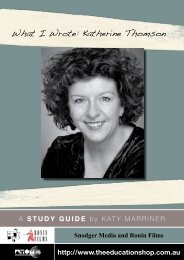
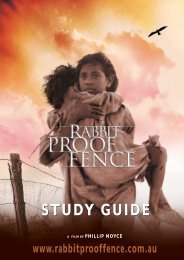

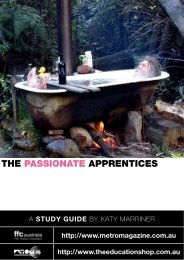
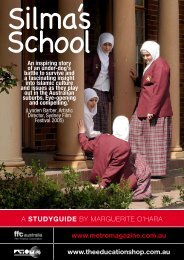
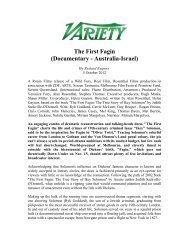

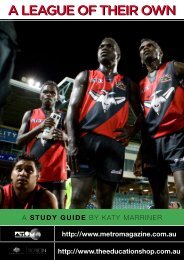
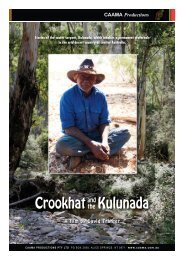
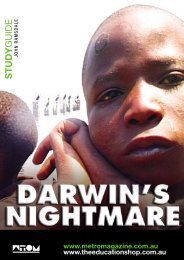
![to download FROHE OSTERN! [HAPPY EASTER!] - Ronin Films](https://img.yumpu.com/33740736/1/184x260/to-download-frohe-ostern-happy-easter-ronin-films.jpg?quality=85)
